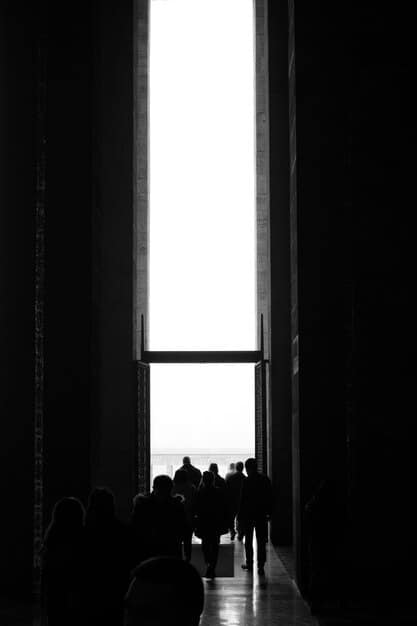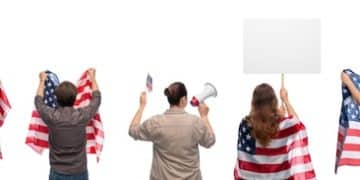Religion in Schools: Prayer, Bible Study, and the Law

Religion in public schools navigates a complex legal landscape, balancing students’ religious freedom with the Establishment Clause of the First Amendment, which prohibits government endorsement of religion; prayer and Bible study are central to this debate, with legal precedents shaping the permissible boundaries of religious expression in educational settings.
The intersection of religion and public education in the United States is a delicate balancing act. The question of the role of religion in public schools: are prayer and bible study violating the separation of church and state, and what are the legal precedents?, continues to spark debate and legal challenges, as communities grapple with how to respect students’ religious freedoms while upholding the principle of separation of church and state.
Religion in Public Schools: A Constitutional Tightrope
The presence of religion in public schools is a topic fraught with legal and social complexities. Striking the right balance between accommodating students’ religious practices and upholding the Establishment Clause of the First Amendment—which prohibits government endorsement of religion—is a constant challenge. This section explores the constitutional framework that governs religion in schools.
The Establishment Clause and Free Exercise Clause
The First Amendment’s religion clauses are often seen as being in tension with each other. The Establishment Clause prevents the government from establishing a religion, while the Free Exercise Clause protects individuals’ rights to practice their religion freely.
In the context of public schools, this means that schools cannot promote or endorse any particular religion, but they also cannot unduly restrict students’ religious expression.
- Establishment Clause: Prohibits government endorsement of religion.
- Free Exercise Clause: Protects individuals’ rights to practice their religion.
- Tension: Balancing these two clauses is a constant challenge for schools.
- Student Rights: Students retain religious freedom rights in schools.
Navigating these constitutional principles requires careful consideration of students’ rights, school policies, and community values. Over time, legal precedents established in landmark Supreme Court cases have helped clarify the permissible boundaries for religious activities in public schools.
Prayer in Schools: Legal Battles and Student Rights
Prayer in schools has been a contentious issue, resulting in several landmark Supreme Court cases. Understanding these legal precedents is crucial for navigating the complex landscape of student religious expression in public schools properly. This section delves into the history of prayer in schools and the evolution of legal perspectives.

Engel v. Vitale (1962)
This landmark case challenged a New York State Board of Regents-approved prayer in public schools. The Supreme Court ruled that mandatory prayer in public schools is unconstitutional, violating the Establishment Clause.
The Court reasoned that by providing a prayer, even a non-denominational one, the state was endorsing religion.
Abington School District v. Schempp (1963)
This case addressed the constitutionality of mandatory Bible readings in public schools. The Supreme Court ruled that requiring students to participate in Bible readings or Lord’s Prayer recitations also violated the Establishment Clause.
These rulings established a clear precedent against school-sponsored or mandated religious activities.
- Engel v. Vitale: Outlawed mandatory school prayer.
- Abington v. Schempp: Prohibited mandatory Bible readings.
- Establishment Clause: Both cases centered on violations.
- Student Rights: Students can still engage in private prayer.
Student-Led Prayer and Moments of Silence
Despite the prohibition of school-sponsored prayer, students retain the right to engage in individual or group prayer as long as it does not disrupt the educational environment. Many schools permit students to lead prayer during non-instructional time, such as before or after school, during lunchtime, or in designated areas.
Some states have implemented “moment of silence” laws. The legality of these laws often depends on their specific wording and intent. If the moment of silence is intended to promote prayer, it may be deemed unconstitutional. However, if the moment of silence is intended to allow for reflection, meditation, or personal contemplation, it may be permissible.
The courts balance the students’ right to free exercise and the need to avoid endorsing a religion.
Bible Study in Schools: Academic Study vs. Religious Practice
Bible study in public schools can take various forms, raising different constitutional concerns. When the Bible is studied from a literary or historical perspective, it is generally permissible. However, devotional Bible study can raise Establishment Clause concerns. This section separates these two approaches.
Academic Study
Studying the Bible as literature or history is generally permitted in public schools. This approach focuses on the Bible’s cultural, historical, and literary significance rather than its religious doctrine. Courses may explore the Bible’s influence on western civilization, its literary style, or its historical context.
The key is that the study is objective and does not promote religious belief.
Devotional Practice
Devotional Bible study, which aims to foster religious belief or practice, is generally not permissible in public schools. This type of study often involves prayer, worship, or promoting a particular religious interpretation.
Such activities can be seen as endorsing religion, violating the Establishment Clause.

- Academic Study: Permissible when focused on history or literature.
- Devotional Practice: Not allowed due to Establishment Clause concerns.
- Objectivity: Critical for permissible Bible study.
- Context: Determines the constitutionality of Bible study.
Therefore, determining the constitutionality of Bible study depends heavily on the context and the purpose of the activities. Studying the Bible for its historical and literary value is permissible, with focus on objective learning instead of devotional activities.
The Equal Access Act: Leveling the Playing Field for Religious Groups
The Equal Access Act (EAA) of 1984 plays a significant role in regulating religious expression in public secondary schools. The EAA requires schools that receive federal funding and allow non-curricular student groups to meet to provide equal access to all student groups, regardless of their religious, political, philosophical, or other content of their speech.
Requirements of the EAA
The EAA seeks to ensure that schools do not discriminate against student groups based on their viewpoint. If a school allows one or more non-curricular student groups to meet on school premises during non-instructional time, it must allow all student groups, including religious groups, the same opportunities.
Non-curricular groups are those not directly related to the school’s curriculum.
Impact on Religious Groups
The EAA has been instrumental in providing religious student groups with the opportunity to meet, pray, and study the Bible on school campuses. These groups must adhere to the same rules and regulations as other non-curricular student groups, such as obtaining permission to meet, not disrupting school activities, and not being financed by the school.
The EAA has expanded the religious presence in public schools.
- Equal Access Act: Ensures equal treatment for student groups.
- Non-Curricular Groups: Applies to groups outside the curriculum.
- Religious Groups: Provided with opportunities to meet and pray.
- Limitations: Groups must follow school rules.
In conclusion, The Equal Access Act ensures that public secondary schools cannot discriminate against a student. This federal law has been instrumental in expanding the presence of religious student groups. Schools must navigate these legal frameworks to respect student rights and uphold religious neutrality.
Accommodating Religious Practices: Balancing Beliefs and School Policies
Public schools are expected to accommodate students’ religious practices to the extent that it does not unduly disrupt the educational environment or infringe upon the rights of others. This can involve various accommodations, such as allowing students to wear religious attire, observing religious holidays, or modifying school activities to align with religious requirements. This section explores the parameters in which schools can create a successful learning environment.
Religious Attire and Symbols
Students have the right to wear religious attire and symbols as an expression of their faith. Schools cannot prohibit students from wearing religious clothing unless it poses a genuine safety hazard or substantially disrupts the educational environment. The key consideration is whether the attire or symbol interferes with the student’s ability to learn or the school’s ability to maintain order.
The school is responsible for ensuring that the students uphold these rights in a safe manner that does not disrupt other students.
Religious Holidays and Observances
Schools must also consider students’ requests to observe religious holidays. While schools are not required to close for every religious holiday, they should make reasonable accommodations for students who need to be absent for religious observances. This may involve allowing students to make up missed work or providing alternative assignments that do not conflict with their religious beliefs.
Some schools also create inclusive environments that include religious understanding.
- Religious Attire: Students have the right to wear religious clothing.
- Religious Holidays: Schools must reasonably accommodate absences.
- Undue Disruption: Accommodations should not disrupt education.
- Balancing Act: Respecting beliefs while maintaining order.
Navigating these religious accommodations requires schools to adopt a case-by-case approach, balancing the values and respecting students’ religious diversity.
Navigating Controversies: Best Practices for Schools
Given the complex legal landscape of religion in public schools, it is essential for schools to adopt best practices that promote understanding, respect, and inclusivity. These issues include developing clear policies, providing training for staff, and fostering open communication with parents and the community. This section highlights potential controversies and their resolution.
Developing Clear Policies
Schools should have clear and comprehensive policies that address religious expression, accommodation, and discrimination. These policies should be developed in consultation with legal counsel, educators, parents, and community stakeholders. The policies should be easily accessible to all members of the school community and regularly reviewed and updated as needed.
Ensure to update policies and keep them in line with federal laws as they change.
Providing Training for Staff
Teachers and school staff play a crucial role in implementing school policies related to religion. It is important to provide them with ongoing training on religious diversity, legal requirements, and best practices for accommodating students’ religious needs. Teachers should learn how to respond to religious expression respectfully and appropriately, without endorsing or disparaging any particular belief.
Training staff ensures that they understand religious diversity.
- Clear Policies: Address expression, accommodation, and discrimination.
- Staff Training: Educate on diversity and legal requirements.
- Open Communication: Foster dialogue with parents and community.
- Respectful Environment: Promote inclusivity and understanding.
Ultimately, by implementing clear and understanding policies and having open communication. Navigating the complexities of religion in public schools requires ongoing effort and a commitment to creating a welcoming and respectful environment for all students.
| Key Point | Brief Description |
|---|---|
| ⚖️ Separation of Church and State | Balances religious freedom with no government endorsement of religion. |
| 🙏 Prayer in Schools | Mandatory prayer is unconstitutional, but private prayer is protected. |
| 📖 Bible Study | Academic study is allowed; devotional practice is restricted. |
| 🤝 Equal Access Act | Ensures equal opportunities for religious student groups in schools. |
FAQ
Mandatory, school-sponsored prayer is unconstitutional. However, students can engage in private, voluntary prayer that does not disrupt the educational environment. School policies should respect both types of prayer accordingly.
Yes, schools can teach about the Bible from a historical or literary perspective, focusing on its cultural and historical significance. However, devotional or religious instruction is typically not allowed in public schools.
The Equal Access Act requires public secondary schools that receive federal funds to provide equal access to student groups regardless of their religious, political, philosophical, or other viewpoints, as long as they’re non-curricular.
Generally, yes. Students have the right to wear religious attire and symbols as an expression of their faith unless it poses a safety hazard or significantly disrupts the educational environment. School policies can have some limitations.
Schools should make reasonable accommodations for students who need to be absent for religious observances, such as allowing them to make up missed work or providing alternative assignments that do not conflict with their religious beliefs.
Conclusion
In conclusion, the relationship between religion and public schools in the United States is complex and constantly evolving. Striking the right balance between respecting students’ religious freedom and upholding the principle of separation of church and state requires understanding of legal precedents, sensitivity to diverse beliefs, and careful implementation of school policies.





